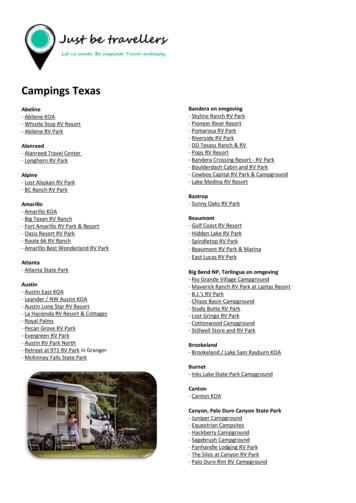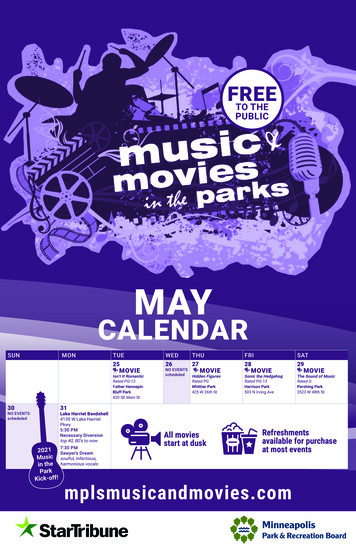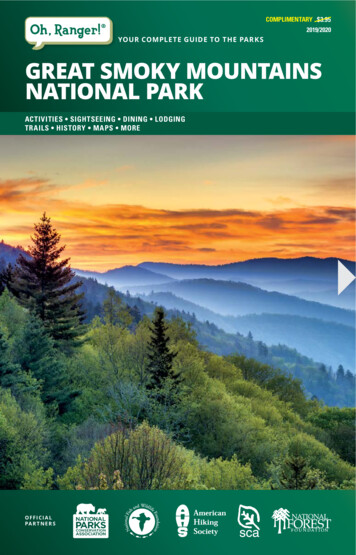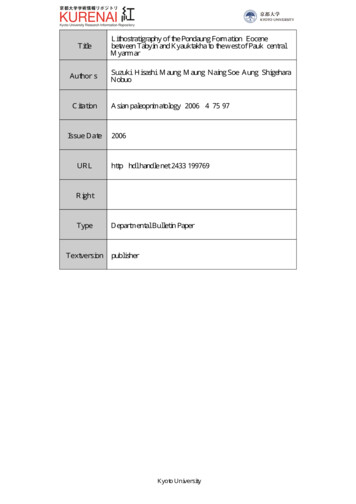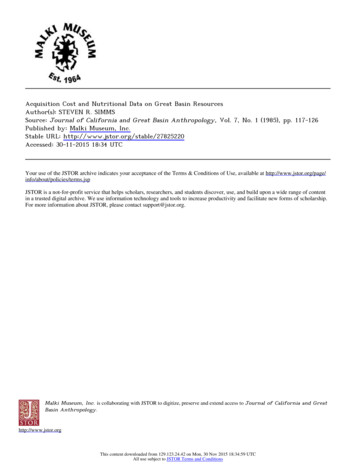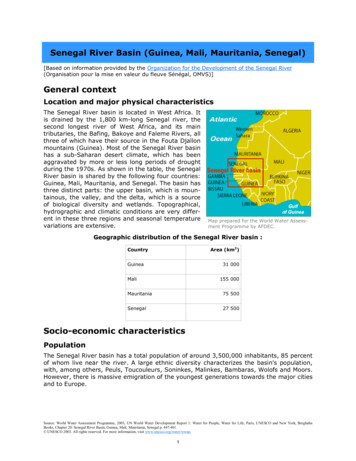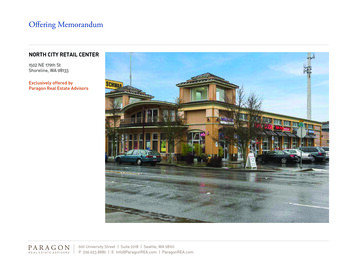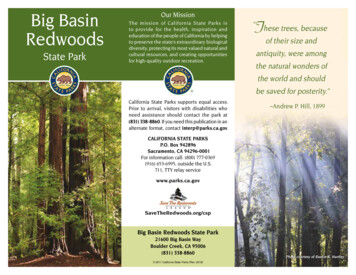
Transcription
Big BasinRedwoodsState ParkOur MissionThe mission of California State Parks isto provide for the health, inspiration andeducation of the people of California by helpingto preserve the state’s extraordinary biologicaldiversity, protecting its most valued natural andcultural resources, and creating opportunitiesfor high-quality outdoor recreation.“These trees, becauseof their size andantiquity, were amongthe natural wonders ofthe world and shouldbe saved for posterity.”California State Parks supports equal access.Prior to arrival, visitors with disabilities whoneed assistance should contact the park at(831) 338-8860. If you need this publication in analternate format, contact interp@parks.ca.gov.–Andrew P. Hill, 1899CALIFORNIA STATE PARKSP.O. Box 942896Sacramento, CA 94296-0001For information call: (800) 777-0369(916) 653-6995, outside the U.S.711, TTY relay servicewww.parks.ca.govSaveTheRedwoods.org/cspBig Basin Redwoods State Park21600 Big Basin WayBoulder Creek, CA 95006(831) 338-8860 2011 California State Parks (Rev. 2018)Photo courtesy of Ruskin K. Hartley
Big Basin Redwoods, California’s oldeststate park, covers more than 18,000 acresranging from sea level to more than 2,000feet elevation. This acreage launched thestate park movement in California.Big Basin’s biggest attraction— literally—is a rare stand of awe-inspiring, ancientcoast redwoods that are among the tallestand oldest trees on Earth. Some measuremore than 300-feet tall and 50 feet incircumference. Scientists estimate thatthese trees may range from 1,000 to 2,500years old.Spectacular views of the Pacific Ocean,lush waterfalls, more than 80 miles of roadsand trails, and a fascinating natural andcultural history have beckoned millions ofvisitors to Big Basin since 1902.natiHumans lived in or near Big Basin for atleast 10,000 years before the Spanishexplored the area in the late 1700s. TheBig Basin area was home to the Cotoniand Quiroste tribes, two of more than 50tribes comprising theOhlone culture of the SanFrancisco and MontereyBay areas.Grinding rocks, whereNative People poundedacorns and other seedsinto flour, are evidencethat today’s parklandserved as the interior“food basket” for coastalpeople. They harvestedseeds of grassland plants in the meadowsand gathered soap root and other bulbs forfood and other uses. Parts of willow, sedge,horsetail, and fern were used to createbaskets. They hunted elk, pronghorns,and mule deer. The Quiroste and Cotoniused fire and other land-managementpractices to promote the growth ofuseful plants and maintain a healthy andproductive ecosystem.The Ohlone led resistance to the localSpanish mission influence in the late 1700s.Eventually, tribal culture collapsed in theface of contagious European diseases,natural-resource destruction, and thesuppression of their native customs. Today,descendants of these tribes are workingtoward federal recognition and revitalizingtheir native traditions.THE REDWOODSBig Basin’s coast redwoods, Sequoiasempervirens, are native to the UnitedStates; they grow only along the coast fromsouthern Oregon to Central California.The name Sequoia mayhonor Sequoyah, the19th-century inventor ofthe Cherokee alphabet,and sempervirens means“ever living.” These treesare part of a once-hugeancient forest of whichless than 5 percentremains. The redwoodis California’s officialstate tree.Sawmill, 1900Sempervirens Club with the famousFather of the Forest tree, 1901The Santa Cruz redwood forest was firstnoted in accounts of a Spanish coastalexpedition led by Gaspar de Portolá in1769. Less than a century later, logging—to meet the demands of the Gold Rushand urban development — threatened todeplete the forest. By 1884, the area’s 28sawmills were annually processing morethan 34 million board feet of lumber, aswell as shingles, railroad ties, and posts.PARK HISTORYAs logging continued, a battle to protectthe ancient trees in the heart of Big Basinbecame the focus of citizens united tosave the redwoods. Photographer AndrewP. Hill, journalist Josephine McCrackin,writer-publisher Carrie Stevens Walter,and a growing coalition of journalists,politicians, artists, businessmen, andscholars formed the Sempervirens Club inMay of 1900.As Walter wrote, “Once gone, no humanpower or ingenuity can replace them.
Even the mostcallous-mindedmaterialist doesnot love to thinkof this swirlingglobe as atreeless place.”The SempervirensClub enlisted andmobilized supportersthroughout thestate to join therace to passlegislationthat wouldprotect BigBasin’s ancientThe forest supports a variety ofredwoods. Inlife. Top to bottom: false turkeytail fungus, western azalea,March 1901,banana sluga State bill createdCalifornia Redwood Park (renamed BigBasin Redwoods State Park in 1927).In the 1930s, the Civilian ConservationCorps constructed the redwood NatureLodge and Park Headquarters, a campfirecenter, footbridges, cabins, stoves, and atrail network.Today, preservation of the park’s naturalwonders has returned to the forefront.The emphasis is preservation of theforest’s entire ecology, with its significantgeologic features, wildlife corridors, andmassive watershed.The park continues to grow throughpartnerships with private nonprofit groupssuch as Save the Redwoods League andthe Sempervirens Fund.NATURAL HISTORYEcology and vegetationSome redwoods measure more than 300feet tall and 50 feet in circumference.However, with no taproot, redwood treesrely on a network of far-reaching rootsabout six-feet deep, intertwined withthose of other redwoods. Soil compactionis a danger to these roots. Knobconepine, Douglas-fir, red alder, madrone,chinquapin, and buckeye also growhere. The forest’s tanoak tree bark onceprovided tannin for local leather tanneries.Huckleberry, azaleas, wild orchids, ferns,manzanita, Indian paintbrush, and poppiesdot the park.Wildlife, Geology, and ClimateFoxes, coyotes, and bobcats livethroughout the park. Banana slugs feed onorganic matter, plants, and mushrooms onthe forest floor. Newts, lizards, and frogs arebountiful in the coast’s damp, moist climate.California quail, brown creepers, variouswoodpeckers, owls, and flickers are somecommon bird species found in the park.Be alert for rattlesnakes, poison oak, andticks. Use caution if you see a mountain lion;report aggressive encounters to park staff.Geologically, the park’s rock formationsare a “Franciscan assemblage”— outcrops ofserpentinite, basalt, limestone, ribbon chert,graywacke, sandstone, and shale.Each season offers a different parkexperience. The intense greens of mossescontrast with the subtle colors of lichensand mushrooms during wet winters. Rushingwaterfalls and wildflowers abound in thecool, foggy spring. Find a shady getawayfrom inland heat in summertime. Falloffers pleasant weather without storms,mosquitoes, or extreme heat.Climate change affects the redwoodforest. Coast redwoods receive much of theirwater and nutrients from fog drippings. A2010 University of California, Berkeley studyfound that the coast now has 75 percentfewer foggy days than it did a century ago.Mature redwoods can survive, but fewerfoggy days mean fewer seedlings matureinto trees.RECREATIONAL ACTIvITIESA year-round activity schedule can befound on the park’s website. The park’sNature Lodge Museum and the VisitorCenter have natural and cultural exhibits.The coastal Rancho del Oso Nature andHistory Center offers exhibits and guidedtours; call (831) 427-2288.Camping — 146 family campsites, four groupcamping sites, tent cabins, backcountry trailcamps, and horse camping are available. Forcomplete camping options and reservations,visit www.parks.ca.gov/bigbasin or call(800) 444-7275. For reservations to theInterpretive programs at the campfire center
Rancho del Oso Horse Camp near WaddellBeach, call (831) 338-8861. For LittleBasin Group Camp information, call(831) 338-3314.Backpacking — Big Basin has fivebackcountry trail camps for backpackers.These trail camps are connected to awider network of trails throughout PortolaRedwoods State Park, Castle Rock StatePark, and Butano State Park. This network oftrail camps gives backpackers the chance totake multiday trips along the famed Skylineto the Sea Trail and beyond. Reservationsand permits are required, and no dispersedcamping is permitted. For informationand reservations, visit www.parks.ca.gov/scmtrailcamps.Trails — Big Basin’s 80 miles of roadsand trails introduce visitors not onlyto the redwoods, but to the park’sdifferent habitats and plants. Guided hikesare scheduled.The easy stroller- andwheelchair-accessibleRedwood Loop Trailwinds a half-milethrough the ancientredwood environment.Visitors can see OpalCreek, some of thelarger old-growth trees, a redwood ring, andthe giant Mother and Father of the Foresttrees. Rated moderate, the Sequoia Trailpasses spectacular Sempervirens Falls. Astrenuous hike on the Berry Creek FallsTrail passes many of the largest old-growthredwood trees, Berry Creek, and its fourwaterfalls. The 33-mile Skyline to the Seaand restrooms. See http://access.parks.ca.gov for details.Sempervirens FallsTrail runs from Castle Rock State Park throughBig Basin to Waddell Beach at Rancho delOso. During the winter, seasonal bridges onthe Skyline to the Sea Trail are removed whenWaddell Creek is high.ACCESSIBLE FEATURESRestrooms and showers are accessible. Parking,eight campsites, three tent cabins, the mainpicnic area, and several trails are accessible, asare the main Visitor Center, Park Headquarters,the Rancho del Oso Nature and History Center,please All natural and cultural features in thepark are protected by law and may notbe disturbed or removed. Collecting isprohibited, including down wood. Purchase firewood from the park storeor camp hosts. Be prepared for mosquitoes in summer. Feeding wildlife is prohibited by law. Be crumb clean! Please do not leavefood out— not even a crumb. Usefood lockers and don’t leave anyfood unguarded. Dispose of all trash properly. Recycleglass, plastic, and aluminum. Except for service animals on a leash nolonger than six-feet long, dogs are neverallowed on any trails, unpaved service/fire roads, in any portion of Rancho delOso, or on Waddell Beach.THE mARBLED mURRELET, a seabird about the size of a robin, is a redwoods inhabitantlisted as endangered in California and threatened in the U.S.The murrelet nests high on a limb in the redwood canopy,hundreds of feet above ground. The bird travels up to30 miles at dawn and dusk to feed on herring, smelt,or anchovies as it swims through the ocean. Themurrelet parents trade off for morning and eveningfeeding; the mother hatches only one chick peryear. Marbled murrelet eggs and babies are prey tothe park’s corvids — jays, crows, and ravens. They arefirst attracted to food or crumbs left by humans, andthen the corvids notice the murrelet nests high in trees.Photo Courtesy of Rich MacIntosh
bigThe establishment of Big Basin RedwoodsState Park in 1902 marked the beginning ofthe preservation and conservation movementin California and provided the vision for thehundreds of California state parkswe enjoy today.In 1900, San Josephotographer Andrew P.Hill photographed thecoast redwood trees inFelton Grove, now part ofHenry Cowell RedwoodsState Park. The then-ownerof the forest accused Hill oftrespassing and demandedAndrew P. Hill his negatives. Hill refusedself-portrait, 1915and left, vowing to himself tosave the trees for future generations and “make apublic park of this place.”After a landmark meeting at Stanford Universityin May of 1900, Santa Cruz businessmen ledHill, journalists, and politicians on an excursionto Big Basin, an ancient forest threatened bylogging. After three days of exploring the forest’swonders, the group elected officers and formedthe Sempervirens Club.The club and its growing team of supporterspushed the State Legislature to approve a bill topurchase the land. The bill passed unanimously.Thus was established California RedwoodPark— known since 1927 as Big Basin RedwoodsState Park.Andrew P. Hill photographed much of theearly history of Big Basin:Father of the Forest redwood, ca. 1915Sempervirens Club annual meeting,ca. 1915Campfire benches andtents, ca. 1915nearbyAño Nuevo State Park20 miles N of Santa Cruz on Hwy. 1Pescadero 94060 (650) 879-2025Butano State Park1500 Cloverdale RoadPescadero 94060 (650) 879-2040Castle Rock State Park15000 Skyline Blvd.Los Gatos 95030(408) 867-2952This park receives support in partthrough two nonprofit organizations:Mountain Parks Foundation (inland areas)525 N. Big Trees Park Rd., Felton, CA 95018(831) 335-3174 www.mountainparks.orgWaddell Creek Association (Rancho del Oso)3600 Highway 1, Davenport, CA 95017(831) 427-2288 www.ranchodeloso.org
g2000eeksUnioadRoS e a ilTraShadouoiaSeqwbrook TrailBob KirschConnector TrailTentCabinsEast RidgeConnector TraililTrawRidgeRdTrailopuoiaaTrMeadoLooddw oRe300 MetersaWto Santa omsHammon20see detail map100TrailHih SkyCo n Ha linenn mmector ondTraOpilalkeeCr00SeqPEastRdBloomsCreeke inPin ntaou ilM Tra10PRidgeilTraBloomsCreekstN0Park HeadquartersVisitor Center1000ft305mEaA1illE1,000 5236EastRid0.5 Mi1 KmgeTrail 2011 California State Parks (Rev. 2018)C500toaSkylinePACIFIC OCEANMORangerStation0PPHooverNatureTrailRancho del OsoNature andHistory CenterSequoiaOldLodgeeek1000BBRSPWaddellBeachS k y l in eCrUPntoth eTheodore J.HooverNaturalPreserveRancho delOso Natureand HistoryCenterSe1ilneRd MtSeth eS ky l i ne toAlderlTraiMa r sh TraPilWaddelBBRSP00PSkyMeadowEastCrth rlFoepingCrTrailgeWestridBthe Se Opal lKinCreekHenryWadRideSkyl i nNoils sFallsP2000eeSha d oSlipperyRockNature LodgeMuseum & Storeryto1ra i laTerCPRdtoBoulderCreek,Hwy 9adquoTra 10r eskolFoCreeRedwDoucCm isonr o okGazosgC2 KilometerswbTrlBipingolHAee kEagle RockMaddock FamilyCabin SitestCr00Skyline to theSea Bypass TrailTwinRedwoodsTrai lis on C rk101.25 Miles11.500JaaTr00ypa s s0.7510'PJa m4010000.50.510TrailCreeoN(reservations only)100.250eeCrTrailCBasintleLittle Basin ConcessionGroup CampgroundEagle RockCrCo ClarknneTra ctorilek0Scott00kreeCre00Buzzard’sRoost SpurTrail2208ft673moLitilTraopSeaC r ekeAñSempeCreekWadd1000eky CreBerrCanyon00LB ar kTrms10Pine Mtneekooailrel ksC haWestadRoellLastpn00PMarine EducationCenterTrailB a r k LoTanoPig RidgeCutoff Trail2000Last ChancePark Entrance236see detail 758m10AÑONUEVOS TAT EPA R KEastWknaPieDo10eBlChanc100011000BloomsCreekene toadWilTraa lkse1000ylitgeeEast RidgJay00CradLodge RdBuzzard’s ersRodRd236P1000gto thoiWastahiTrailSeaSkHuckleberryardS T AT E W I L D E R N E S SWesquTrlek236SkyMeadowPinWA D D E L LPA R KRdtTrail2150ft655mS TAT ESeEscapekr esCre236CASTLEROCKS TAT EPA R KderthreeFoe RdHowthtoeKelly0Skyline to the SeaToll RoadConnector TrailTrailulNodgTrailWESTck CSunsetConnectorTrailk00thePmondn Ham HoHihwardMt McAbee Overlook10ddogRoadTrailAÑOMaCreepinRitkkilTra’s CreeCreeeeS k yl i reekFallstWesBike RackmTimllssaz009WatermanGapHenry CowellRedwoods 1SP236CrOcean View SummitdleTiChalk MtnNUEVOSuFaalkRdCh00ek1000dg tehoeTr useSuCreGoldenFalls nsesm’my002000Skyline toTrailMidCreeknrRdW h i t e h o us e C r e e kWoners dAndding RLanerryHe101000TreeRodgersSunsetseteho uhiwBIG BASINREDWOODSS TAT E PA R KPrivatePropertyInholdingtBWes00lloWatermanGap santoHwy. 1Gazos Creek Rd(closed seasonally)00escPortolaaderoRedwoods SPrBoWaterfallBouldetleCrRestroomsCampfire CentersinRanger Station/OfficeAccessible FeatureViewpointLiteilTra(By Reservation Only)Telephonead2000RoPicnic AreaBridgeGrRedwoodsConcession-OperatedGroup CampgroundBridge: Seasonalna1000TrailHollow TreeParkingPWilderness Area100RdCreekNo Public Access(Hike, Bike & Horse)10reSanJosePescadero CreekCounty ParkPCreekhiMarshTrail: Multi-useFiGazosLaneCTrail: Hike & Horse0to Cutter ScoutReservationnoBaLocked Gate010tailTraTrail: HikeBuPA R KHorse Staging Areato Saratoga/Skyline Blvd000k y l i n e toS TAT ECampground: PrimitiveTrail: Accessible101002000ent(Open to Hike, Bike & Horse)2000Unpaved Fire/Service Rd.Ease mB U TA N OCampground: Horse00State ParkCampground: GroupPaved Roadto Portola Redwoods SPand Pescadero CreekCounty ParkBasinBig Basin RedwoodsCampgroundMajor Road10Legend
The park continues to grow through partnerships with private nonprofit groups such as Save the Redwoods League and the Sempervirens Fund. NATURAL HISTORY Ecology and vegetation. Some redwoods measure more than 300- feet tall and 50 feet in circumference. However, with no taproot, redwood trees rely on a network of far-reaching roots
